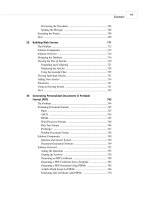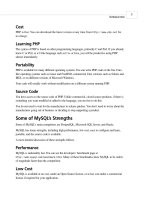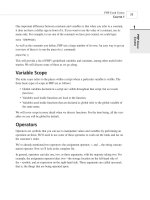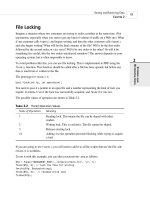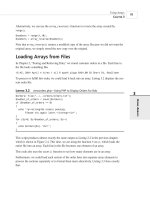Phát triển web với PHP và MySQL - p 4 ppsx
Bạn đang xem bản rút gọn của tài liệu. Xem và tải ngay bản đầy đủ của tài liệu tại đây (430.03 KB, 10 trang )
INTRODUCTION
Cost
PHP is free. You can download the latest version at any time from for
no charge.
Learning PHP
The syntax of PHP is based on other programming languages, primarily C and Perl. If you already
know C or Perl, or a C-like language such as C++ or Java, you will be productive using PHP
almost immediately.
Portability
PHP is available for many different operating systems. You can write PHP code on the free Unix-
like operating systems such as Linux and FreeBSD, commercial Unix versions such as Solaris and
IRIX, or on different versions of Microsoft Windows.
Your code will usually work without modification on a different system running PHP.
Source Code
You have access to the source code of PHP. Unlike commercial, closed-source products, if there is
something you want modified or added to the language, you are free to do this.
You do not need to wait for the manufacturer to release patches. You don’t need to worry about the
manufacturer going out of business or deciding to stop supporting a product.
Some of MySQL’s Strengths
Some of MySQL’s main competitors are PostgreSQL, Microsoft SQL Server, and Oracle.
MySQL has many strengths, including high performance, low cost, easy to configure and learn,
portable, and the source code is available.
A more detailed discussion of these strengths follows.
Performance
MySQL is undeniably fast. You can see the developers’ benchmark page at
Many of these benchmarks show MySQL to be orders
of magnitude faster than the competition.
Low Cost
MySQL is available at no cost, under an Open Source license, or at low cost under a commercial
license if required for your application.
5
01 7842 intro 3/6/01 3:33 PM Page 5
PHP AND MYSQL WEB DEVELOPMENT
Ease of Use
Most modern databases use SQL. If you have used another RDBMS, you should have no trouble
adapting to this one. MySQL is also easier to set up than many similar products.
Portability
MySQL can be used on many different UNIX systems as well as under Microsoft Windows.
Source Code
As with PHP, you can obtain and modify the source code for MySQL.
How Is This Book Organized?
This book is divided into five main sections.
Part I, “Using PHP,” gives an overview of the main parts of the PHP language with examples.
Each of the examples will be a real-world example used in building an e-commerce site, rather
than “toy” code. We’ll kick this section off with Chapter 1, “PHP Crash Course.” If you’ve already
used PHP, you can whiz through this section. If you are new to PHP or new to programming, you
might want to spend a little more time on it.
Part II, “Using MySQL,” discusses the concepts and design involved in using relational database
systems such as MySQL, using SQL, connecting your MySQL database to the world with PHP,
and advanced MySQL topics, such as security and optimization.
Part III, “E-Commerce and Security,” covers some of the general issues involved in developing an
e-commerce site using any language. The most important of these issues is security. We then dis-
cuss how you can use PHP and MySQL to authenticate your users and securely gather, transmit,
and store data.
Part IV, “Advanced PHP Techniques,” offers detailed coverage of some of the major built-in func-
tions in PHP. We have selected groups of functions that are likely to be useful when building an
e-commerce site. You will learn about interaction with the server, interaction with the network,
image generation, date and time manipulation, and session variables.
Part V, “Building Practical PHP and MySQL Projects,” deals with practical real-world issues such
as managing large projects and debugging, and provides sample projects that demonstrate the
power and versatility of PHP and MySQL.
Finally
We hope you enjoy this book, and enjoy learning about PHP and MySQL as much as we did
when we first began using these products. They are really a pleasure to use. Soon, you’ll be
able to join the thousands of Web developers who use these robust, powerful tools to easily
build dynamic, real-time Web sites.
6
01 7842 intro 3/6/01 3:33 PM Page 6
IN THIS PART
1 PHP Crash Course 9
2 Storing and Retrieving Data 49
3 Using Arrays 69
4 String Manipulation and Regular Expressions 93
5 Reusing Code and Writing Functions 117
6 Object-Oriented PHP 147
Using PHP
PART
I
02 7842 part 1 3/6/01 3:42 PM Page 7
02 7842 part 1 3/6/01 3:42 PM Page 8
CHAPTER
1
PHP Crash Course
03 7842 CH01 3/6/01 3:39 PM Page 9
Using PHP
P
ART I
10
This chapter gives you a quick overview of PHP syntax and language constructs. If you are
already a PHP programmer, it might fill some gaps in your knowledge. If you have a back-
ground using C, ASP, or another programming language, it will help you get up to speed
quickly.
In this book, you’ll learn how to use PHP by working through lots of real world examples,
taken from our experience in building e-commerce sites. Often programming textbooks teach
basic syntax with very simple examples. We have chosen not to do that. We recognize that
often what you want to do is get something up and running, to understand how the language is
used, rather than ploughing through yet another syntax and function reference that’s no better
than the online manual.
Try the examples out—type them in or load them from the CD-ROM, change them, break
them, and learn how to fix them again.
In this chapter, we’ll begin with the example of an online product order form to learn how
variables, operators, and expressions are used in PHP. We will also cover variable types and
operator precedence. You will learn how to access form variables and how to manipulate them
by working out the total and tax on a customer order.
We will then develop the online order form example by using our PHP script to validate the
input data. We’ll examine the concept of Boolean values and give examples of using if, else,
the ?: operator, and the switch statement.
Finally, we’ll explore looping by writing some PHP to generate repetitive HTML tables.
Key topics you will learn in this chapter include
• Embedding PHP in HTML
• Adding dynamic content
• Accessing form variables
• Identifiers
• User declared variables
• Variable types
• Assigning values to variables
• Constants
• Variable scope
• Operators and precedence
• Expressions
• Variable functions
• Making decisions with if, else, and switch
• Iteration: while, do, and for loops
03 7842 CH01 3/6/01 3:39 PM Page 10
Using PHP
In order to work through the examples in this chapter and the rest of the book, you will need
access to a Web server with PHP installed. To get the most from the examples and case studies,
you should run them and try changing them. To do this, you’ll need a testbed where you can
experiment.
If PHP is not installed on your machine, you will need to begin by installing it, or getting your
system administrator to install it for you. You can find instructions for doing so in Appendix A,
“Installing PHP 4 and MySQL.” Everything you need to install PHP under UNIX or Windows
NT can be found on the accompanying CD-ROM.
Sample Application: Bob’s Auto Parts
One of the most common applications of any server side scripting language is processing
HTML forms. You’ll start learning PHP by implementing an order form for Bob’s Auto Parts,
a fictional spare parts company. All the code for the Bob’s examples used in this chapter is in
the directory called chapter1 on the CD-ROM.
The Order Form
Right now, Bob’s HTML programmer has gotten as far as setting up an order form for the
parts that Bob sells. The order form is shown in Figure 1.1. This is a relatively simple order
form, similar to many you have probably seen while surfing. The first thing Bob would like to
be able to do is know what his customer ordered, work out the total of the customer’s order,
and how much sales tax is payable on the order.
PHP Crash Course
C
HAPTER 1
1
PHP CRASH
COURSE
11
FIGURE 1.1
Bob’s initial order form only records products and quantities.
03 7842 CH01 3/6/01 3:39 PM Page 11
Part of the HTML for this is shown in Listing 1.1. There are two important things to notice in
this code.
LISTING 1.1 orderform.html—HTML for Bob’s Basic Order Form
<form action=”processorder.php” method=post>
<table border=0>
<tr bgcolor=#cccccc>
<td width=150>Item</td>
<td width=15>Quantity</td>
</tr>
<tr>
<td>Tires</td>
<td align=center><input type=”text” name=”tireqty” size=3 maxlength=3></td>
</tr>
<tr>
<td>Oil</td>
<td align=center><input type=”text” name=”oilqty” size=3 maxlength=3></td>
</tr>
<tr>
<td>Spark Plugs</td>
<td align=center><input type=”text” name=”sparkqty” size=3 maxlength=3></td>
</tr>
<tr>
<td colspan=2 align=center><input type=submit value=”Submit Order”></td>
</tr>
</table>
</form>
The first thing to notice is that we have set the form’s action to be the name of the PHP script
that will process the customer’s order. (We’ll write this script next.) In general, the value of the
ACTION attribute is the URL that will be loaded when the user presses the submit button. The
data the user has typed in the form will be sent to this URL via the method specified in
the METHOD attribute, either GET (appended to the end of the URL) or POST (sent as a separate
packet).
The second thing you should notice is the names of the form fields—tireqty, oilqty, and
sparkqty. We’ll use these names again in our PHP script. Because of this, it’s important to
give your form fields meaningful names that you can easily remember when you begin writing
the PHP script. Some HTML editors will generate field names like field23 by default. These
are difficult to remember. Your life as a PHP programmer will be easier if these names reflect
the data that is typed into the field.
Using PHP
P
ART I
12
03 7842 CH01 3/6/01 3:39 PM Page 12
You might want to consider adopting a coding standard for field names so that all field names
throughout your site use the same format. This makes it easier to remember whether, for exam-
ple, you abbreviated a word in a field name, or put in underscores as spaces.
Processing the Form
To process the form, we’ll need to create the script mentioned in the ACTION attribute of the
FORM tag called processorder.php. Open your text editor and create this file. Type in the fol-
lowing code:
<html>
<head>
<title>Bob’s Auto Parts - Order Results</title>
</head>
<body>
<h1>Bob’s Auto Parts</h1>
<h2>Order Results</h2>
</body>
</html>
Notice, how everything we’ve typed so far is just plain HTML. It’s now time to add some sim-
ple PHP code to our script.
Embedding PHP in HTML
Under the <h2> heading in your file, add the following lines:
<?
echo “<p>Order processed.”;
?>
Save the file and load it in your browser by filling out Bob’s form and clicking the Submit but-
ton. You should see something similar to the output shown in Figure 1.2.
Notice how the PHP code we wrote was embedded inside a normal-looking HTML file. Try
viewing the source from your browser. You should see this code:
<html>
<head>
<title>Bob’s Auto Parts - Order Results</title>
</head>
<body>
<h1>Bob’s Auto Parts</h1>
<h2>Order Results</h2>
<p>Order processed.</p></body>
</html>
PHP Crash Course
C
HAPTER 1
1
PHP CRASH
COURSE
13
03 7842 CH01 3/6/01 3:39 PM Page 13
FIGURE 1.2
Text passed to PHP’s echo construct is echoed to the browser.
None of the raw PHP is visible. This is because the PHP interpreter has run through the script
and replaced it with the output from the script. This means that from PHP we can produce
clean HTML viewable with any browser—in other words, the user’s browser does not need to
understand PHP.
This illustrates the concept of server-side scripting in a nutshell. The PHP has been interpreted
and executed on the Web server, as distinct from JavaScript and other client-side technologies
that are interpreted and executed within a Web browser on a user’s machine.
The code that we now have in this file consists of four things:
• HTML
• PHP tags
• PHP statements
• Whitespace
We can also add
• Comments
Most of the lines in the example are just plain HTML.
Using PHP Tags
The PHP code in the previous example began with <? and ended with ?>. This is similar to all
HTML tags because they all begin with a less than (<) symbol and end with a greater than (>)
symbol. These symbols are called PHP tags that tell the Web server where the PHP code starts
and finishes. Any text between the tags will be interpreted as PHP. Any text outside these tags
will be treated as normal HTML. The PHP tags allow us to escape from HTML.
Using PHP
P
ART I
14
03 7842 CH01 3/6/01 3:39 PM Page 14


